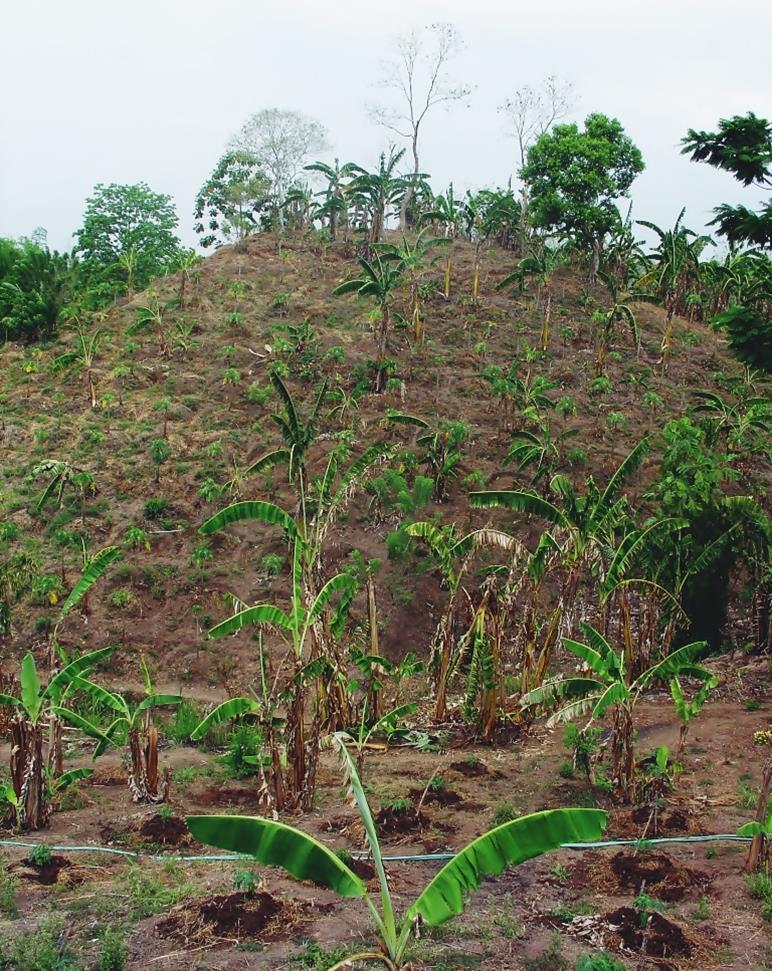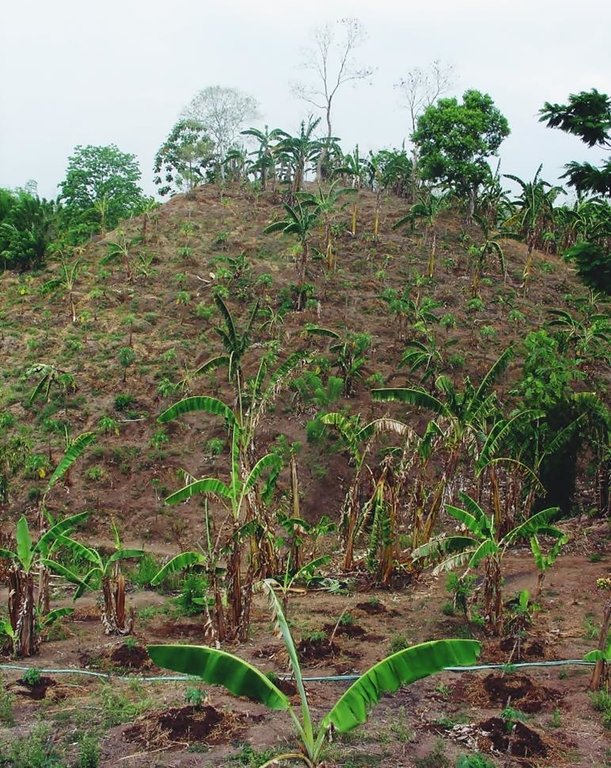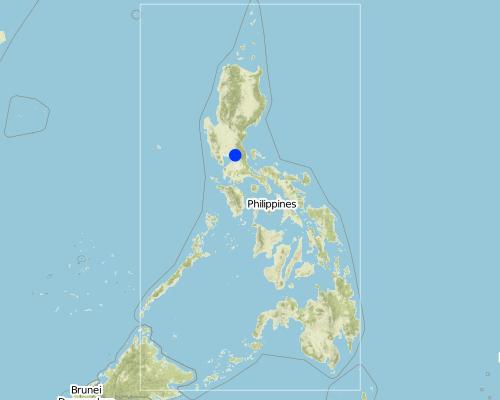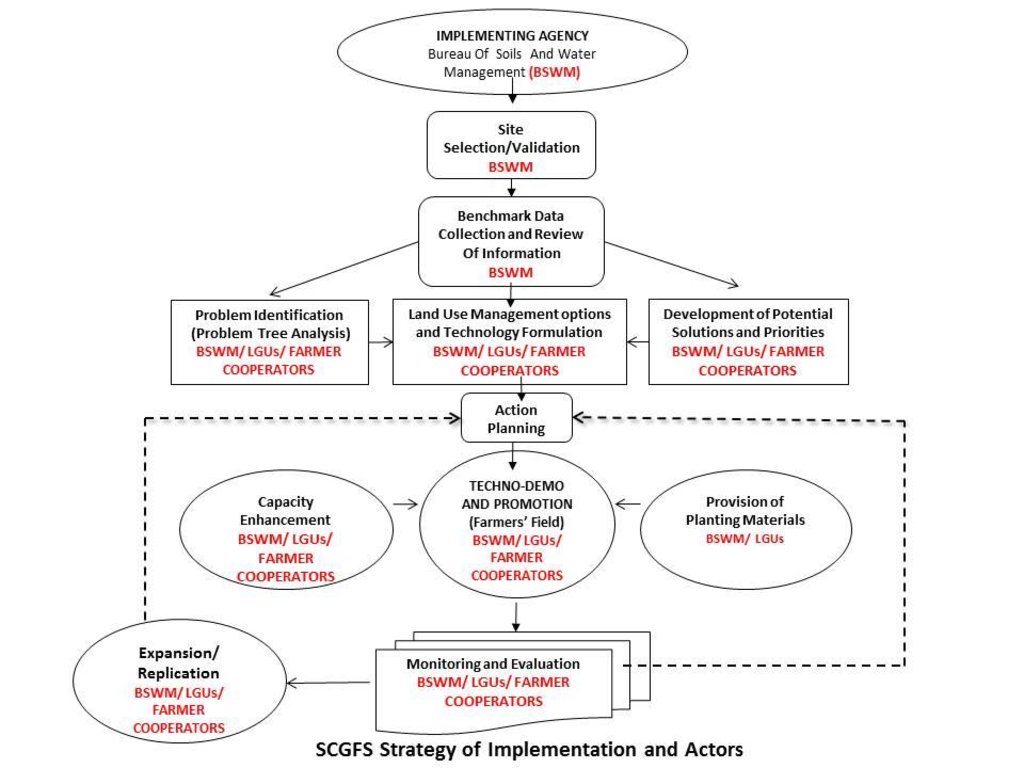Soil Conservation Guided Farm System [Filipinas]
- Creación:
- Actualización:
- Compilador: Philippine Overview of Conservation Approaches and Technologies
- Editor: –
- Revisores: Deborah Niggli, Ursula Gaemperli
SCGFS, Guided Farm, Guided Farm Project
approaches_1973 - Filipinas
Visualizar secciones
Expandir todo Colapsar todos1. Información general
1.2 Detalles de contacto de las personas de referencia e instituciones involucradas en la evaluación y la documentación del Enfoque
Persona(s) de referencia clave/s
Especialista MST:
Especialista MST:
Especialista MST:
Especialista MST:
Dacumos Evangeline
Bureau of Soils and Water Management
Filipinas
Especialista MST:
Creencia Rogelio
Bureau of Soils and Water Management
Filipinas
Especialista MST:
Raquid Jemar
Bureau of Soils and Water Management
Filipinas
Especialista MST:
Guillermo Josephroel
Bureau of Soils and Water Management
Filipinas
Nombre del proyecto que facilitó la documentación/ evaluación del Enfoque (si fuera relevante)
Decision Support for Mainstreaming and Scaling out Sustainable Land Management (GEF-FAO / DS-SLM)Nombre de la(s) institución(es) que facilitaron la documentación/ evaluación del Enfoque si fuera relevante)
Department of Agriculture-Region VIII (DA-8) - Filipinas1.3 Condiciones referidas al uso de datos documentados mediante WOCAT
¿Cuándo se compilaron los datos (en el campo)?
29/06/2016
El compilador y la/s persona(s) de referencia claves aceptan las condiciones acerca del uso de los datos documentados mediante WOCAT :
Sí
1.4 Referencia/s al/los Cuestionario(s) de Tecnologías MST
2. Descripción del Enfoque MST
2.1 Breve descripción del Enfoque
Soil Conservation Guided Farming System (SCGFS) is a land use management approach that integrates technologies: terracing, agro-pastoral technology, multi-storey cropping, and contouring within the socio-economic and bio-physical limitations of upland areas for optimum development of soil and water resource in a sustainable manner.
2.2 Descripción detallada del Enfoque MST
Descripción detallada del Enfoque MST:
Generally, SCGFS aims to promote sustainable land use management that provides agricultural livelihood while protecting and maintaining environmental sustainability in the upland areas of the country. Its specific objectives: (1) Establish community-based and farmer-managed techno demo farms cum learning centers on soil and water conservation in marginal uplands and watersheds of Small Scale Irrigation Projects (SSIPs); (2) Promote and disseminate effective soil and water conservation approaches and technologies for broader adoption; and (3) Develop a strong linkage and partnership among local stakeholders and cooperators to protect our upland resources and watersheds.
Participatory Approach amongst stakeholders as spearheaded by the Bureau of Soils and Water Management (BSWM) through the Soil Conservation and Management Division (SCMD)
Stages of implementation: (1) Coordination with the Local Government Units (LGU) and consultation with farmers; (2) Memorandum of Agreement (MOA) preparation; (3) Reconnaissance survey (a. Site selection/ identification b. Dialogue with farmer cooperators); (4) Field Survey/Ground Truthing (Topographic survey, Land Resources survey); (5) Maps Preparation( Topographic Map, Soil Map, Land Use Map, Slope Map and Erosion Map); (6) Preparation of preliminary Farm Development Plan; (7) Presentation of Farm Development Plan to the LGUs and Farmer Cooperators (Discussion, Revision/modification); (8). Preparation of Project Study Report (Final Farm Development Plan); (9) Institutional Development/ Capacity Building; (10) Implementation Stage / Farm Development; (11)Conduct of season long farmer field school; and (12) Monitoring and Evaluation including Operation and Maintenance.
Role of stakeholders: A. Bureau of Soils and Water Management (BSWM):
1. Provide the over-all direction in the preparation of plans and programs for the implementation of soil and water conservation through the SCGFS;
2. Provide technical support and assistance in the promotion and implementation of soil and water conservation and in the conduct of capacity building activities (i.e. in terms of training modules and resource persons);
B. Partner agencies/institutions (e.g. LGUs and other concerned agencies):
1. Prepare and endorse request to the BSWM for the establishment of SCGFS as demo farm of soil and water conservation technologies;
2. Provide technical support and assistance to the co-operators in the conduct of field survey and investigation, preparation of soil conservation farm plan, establishment of the SCGFS, and undertaking the necessary training activities;
3. In coordination with BSWM, assist the co-operators in availing necessary farm inputs and facilities for the establishment of the SCGFS; and
4. Undertake monitoring and assessment of operation and maintenance of established SCGFS to immediately address on-farm problems.
C. The Farmer Cooperators (i.e. interest groups/individuals):
1. Signify their interest to establish soil and water conservation demo farm through formal request to the BSWM;
2. Be willing to provide their own resources in the establishment of the demo farm;
3. Provide support and assistance to BSWM in the conduct of field survey and investigation;
4. Act as extension agents in the local community to disseminate soil and water conservation technologies with the demo farm as the community learning center.
2.3 Fotos del Enfoque
2.5 País/ región/ lugares donde el Enfoque fue aplicado
País:
Filipinas
Región/ Estado/ Provincia:
Bulacan
Map
×2.6 Fechas de inicio y conclusión del Enfoque
Indique año del inicio:
2002
2.7 Tipo de Enfoque
- proyecto/ basado en un programa
2.8 Propósitos/ objetivos principales del Enfoque
SCGFS aims to promote sustainable land use management that provides agricultural livelihood while protecting and maintaining environmental sustainability in the upland areas of the country. Its specific objectives: (1) Establish community-based and farmer - managed techno demo farms cum learning centers on soil and water conservation in marginal uplands and watersheds of SSIPs; (2) Promote and disseminate effective soil and water conservation approaches and technologies for broader adoption; and (3) Develop a strong linkage and partnership among local stakeholders and cooperators to protect our upland resources and watersheds.
2.9 Condiciones que facilitan o impiden la implementación de la/s Tecnología/s aplicadas bajo el Enfoque
disponibilidad/ acceso a recursos y servicios financieros
- facilitan
Support from BSWM, Department of Agrarian Reform (DAR) & LGUs; Income Generating Technologies
entorno institucional
- facilitan
Organized farmers association
conocimiento de MST, acceso a apoyo técnico
- facilitan
Capacity building, Farmers Field School
carga de trabajo, disponibilidad de mano de obra
- facilitan
Provide additional labor
3. Participación y roles de las partes interesadas involucradas
3.1 Partes interesadas involucradas en el Enfoque y sus roles
- usuarios locales de tierras/ comunidades locales
- especialistas MST/consejeros agrícolas
- gobierno local
Local Government Unit
Si varias partes interesadas estuvieron involucradas, indique la agencia principal:
Land user groups
3.2 Involucramiento de los usuarios locales de tierras/ comunidades locales en las distintas fases del Enfoque
| Involucramiento de los usuarios locales de tierras/ comunidades locales | Especifique quién se involucró y describa las actividades | |
|---|---|---|
| iniciación/ motivación | pasivo | BSWM initiates the establishment of the project. Field surveys i.e site validation, topographic surveys etc. are conducted by BSWM technical staffs. |
| planificación | interactivo | Planning involves both BSWM and LGUs, technology/ies to be established is/are dependent on the biophysical limitation of the area and the needs of farmer cooperators. |
| implementación | interactivo | Implementation of the project requires participatory involvement amongst stakeholders. |
| monitoreo y evaluación | interactivo | BSWM, LGUs and farmer cooperators are responsible in the monitoring and evaluation of the established technologies, these will ensure continued adaptation of the technology. |
3.3 Flujograma (si estuviera disponible)
3.4 La toma de decisiones en la selección de Tecnología(s) MST
Especifique quién decidió la selección de las Tecnología/ Tecnologías a implementarse:
- principalmente por especialistas MST en consulta con usuarios de tierras
4. Apoyo técnico, fortalecimiento institucional y gestión del conocimiento
4.1 Construcción de capacidades / capacitación
¿Se proporcionó la capacitación a usuarios de tierras/ otras partes interesadas?
Sí
Especifique quién fue capacitado:
- usuarios de tierras
- personal de campo/ consejeros
Forma de capacitación:
- de agricultor a agricultor
- áreas de demostración
Forma de capacitación:
- organization, capacity building
Temas avanzados:
Soil and Water Conservation Measures, Land Degradation, Soil Erosion Issues.
4.2 Servicio de asesoría
¿Los usuarios de tierras tienen acceso a un servicio de asesoría?
Sí
Describa/ comentarios:
BSWM is the implementing agency. Advises are coming from the experts/ specialists of BSWM.
4.3 Fortalecimiento institucional (desarrollo institucional)
¿Se establecieron o fortalecieron instituciones mediante el Enfoque?
- sí, un poco
Especifique el nivel o los niveles en los que se fortalecieron o establecieron las instituciones:
- local
Describa la institución, roles y responsabilidades, miembros, etc.
Needy family heads
4.4 Monitoreo y evaluación
¿El monitoreo y la evaluación forman parte del Enfoque?
Sí
Si respondió que sí, ¿la documentación se utilizará para monitoreo y evaluación?
No
4.5 Investigación
¿La investigación formó parte del Enfoque?
No
5. Financiamiento y apoyo material externo
5.1 Presupuesto anual para el componente MST del Enfoque
Si no se conoce el presupuesto anual preciso, indique el rango:
- 2,000-10,000
Comentarios (ej. fuentes principales de financiamiento/ donantes principales):
Government (technical assistance i.e field surveys, provision of planting materials) 20%, local government (technical assistance, planting materials) 60%, local land users (labor, care and maintenance) 20%
5.2 Apoyo financiero/material proporcionado a los usuarios de tierras
¿Los usuarios de tierras recibieron financiamiento/ apoyo material para implementar la Tecnología/ Tecnologías? :
No
5.3 Subsidios para insumos específicos (incluyendo mano de obra)
- equipo
| Especifique qué insumos se subsidiaron | En qué grado | Especifique los subsidios |
|---|---|---|
| maquinaria | totalmente financiado | |
- agrícola
| Especifique qué insumos se subsidiaron | En qué grado | Especifique los subsidios |
|---|---|---|
| semillas | totalmente financiado | |
- infraestructura
| Especifique qué insumos se subsidiaron | En qué grado | Especifique los subsidios |
|---|---|---|
| Greenhouse, Access Roads | totalmente financiado | |
Si la mano de obra de usuarios de tierras fue un insumo sustancial, ¿fue:
- voluntario?
5.4 Crédito
¿Se proporcionó crédito bajo el Enfoque para actividades MST?
No
5.5 Otros incentivos o instrumentos
¿Se usaron otros incentivos o instrumentos para promover la implementación de Tecnologías MST?
No
6. Análisis de impacto y comentarios de conclusión
6.1 Impactos del Enfoque
¿El Enfoque ayudó a los usuarios de tierras a implementar y mantener Tecnologías MST?
- No
- Sí, un poco
- Sí, moderadamente
- Sí, mucho
SCGFS involves the development of farming systems that adopts appropriate land uses, proper combination of crop and animal commodities, and the right mix of soil and water conservation practices. Thus, these measures ensures development in land use, livestock production and conservation measures.
¿El Enfoque empoderó a grupos en desventaja social y económica?
- No
- Sí, un poco
- Sí, moderadamente
- Sí, mucho
The approach aids in income generation for needy family heads.
¿El Enfoque resultó en mejor seguridad alimentaria/ mejoró la nutrición?
- No
- Sí, un poco
- Sí, moderadamente
- Sí, mucho
Crop diversification helps needy farmers increase their income. Farmers who have undergone SLM training have more exposure to sustainable land use management that would help them improve and widen their knowledge in their farming activities.
Did other land users / projects adopt the Approach?
- No
- Sí, un poco
- Sí, moderadamente
- Sí, mucho
Adjacent farms/ barangays and other sloping areas of the Philippines
Did the Approach lead to improved livelihoods / human well-being?
- No
- Sí, un poco
- Sí, moderadamente
- Sí, mucho
Adaptors continue to rise, and with that more farmers generated more income, thus they were able to send their children to school and purchase properties.
6.2 Motivación principal del usuario de la tierra para implementar MST
- producción incrementada
One of the main purpose of the approach is to help farmers increase their production.
- conciencia medioambiental
Farmers will generate income while conserving the land.
- well-being and livelihoods improvement
6.3 Sostenibilidad de las actividades del Enfoque
¿Pueden los usuarios de tierras sostener lo que se implementó mediante el Enfoque (sin apoyo externo)?
- sí
Si respondió que sí, describa cómo:
Technologies are already established and proven to be socially acceptable and economically viable. Farmer cooperators are equipped with technical knowledge they obtained from seminars and training provided by the approach. With these, it ensures sustainability of the project with farmer's own initiative.
6.4 Fortalezas/ ventajas del Enfoque
| Fuerzas/ ventajas/ oportunidades desde la perspectiva del usuario de la tierra |
|---|
| New opportunities for other projects from government |
| Learning center for other barangays |
| Organization of farmers into cooperatives/associations |
| Fuerzas/ ventajas/ oportunidades desde la perspectiva del compilador o de otra persona de referencia clave |
|---|
| Participatory/Interactive method |
| Serves as a learning center for other barangay or farmers |
| Easy to adapt |
| Multi-sectoral involvement |
| Transfer of technologies to farmer beneficiaries |
6.5 Debilidades/ desventajas del Enfoque y formas de sobreponerse a ellos
| Debilidades/ desventajas/ riesgos desde la perspectiva del usuario de la tierra | ¿Cómo sobreponerse a ellas? |
|---|---|
| No major concern in the weaknesses / disadvantages of the approach. |
| Debilidades/ desventajas/ riesgos desde la perspectiva del compilador o de otra persona de referencia clave | ¿Cómo sobreponerse a ellas? |
|---|---|
| Low budget for the establishment of techno-demo | Establish linkages with Local and International funding institutions; development of research proposals for possible funding. |
| Lack of research component particularly in economic and ecological analysis/assessment | Conduct on-site research studies; engage State/Universities and Colleges (SUCs) in research activity. |
7. Referencias y vínculos
7.1 Métodos/ fuentes de información
- visitas de campo, encuestas de campo
- entrevistas con usuarios de tierras
7.2 Referencias a publicaciones disponibles
Título, autor, año, ISBN:
San Jose del Monte Soil Conservation Guided Farm Project: A success Story, Madrid Agribusiness Digest, 2012,pp 36
¿Dónde se halla disponible? ¿Costo?
1.28 USD
Vínculos y módulos
Expandir todo Colapsar todosVínculos
No hay vínculos
Módulos
No se hallaron módulos






